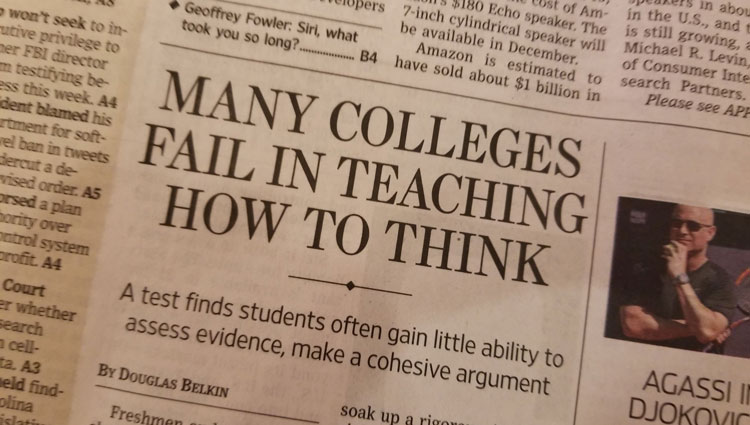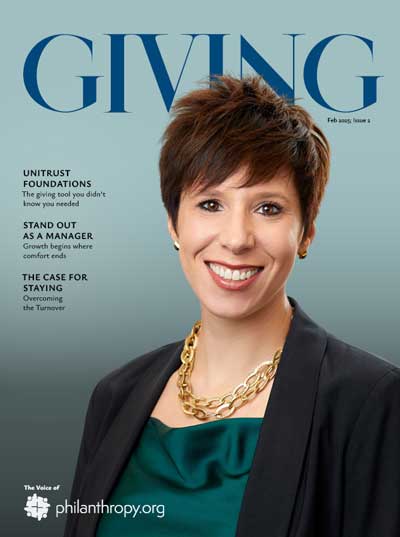While cleaning out old files on my computer, I stumbled across a 2017 newspaper clipping that stopped me cold. The headline, from The Wall Street Journal, read:
“Many Colleges Fail in Teaching How to Think.”
The article, written by Douglas Belkin, reported on results from the College Learning Assessment Plus (CLA+). This exam measured whether students could assess evidence, interpret data, and construct coherent arguments. In plain English: could they think critically?
The answer, disturbingly, was often no. At more than half of the institutions surveyed, at least a third of seniors showed no measurable improvement in reasoning skills between freshman year and graduation. Four years, thousands of tuition dollars, and almost no progress in the very skill that should define a college education.
Back then, it was a headline. Today, it feels like a prophecy.
A Warning Ignored
Rereading that article (PDF download), what struck me wasn’t just the data—it was the date. That was eight years ago. The warning lights were already flashing. Yet most institutions carried on as if nothing were wrong.
Now we’re living with the consequences. Alumni giving is sliding. Colleges are closing at nearly one per week. Public confidence in higher education is at historic lows. The collapse may feel sudden, but it isn’t. It’s the slow-motion result of years of misplaced priorities.
You can’t ignore the fundamentals forever. If students aren’t leaving better thinkers than when they arrived, why should donors keep funding the system?
Donors Are Asking Harder Questions
Philanthropy relies on trust. Donors give because they believe their dollars nurture something worthwhile. But when headlines reveal that graduates can’t build an argument or analyze evidence, alumni start asking:
- Am I funding thinkers—or just diplomas?
- Am I supporting education—or subsidizing amenities?
- Is there any return beyond glossy brochures?
Those aren’t cynical questions. They’re the same kind of accountability checks donors expect from any serious investment. And increasingly, colleges don’t have convincing answers.
Why the Decline Was Inevitable
The erosion of donations and trust didn’t happen overnight. It was built into the model.
For decades, universities poured money into climbing walls, luxury dorms, and layers of administration while quietly neglecting the one thing only they can provide: rigorous education. Employers noticed. Parents noticed. And eventually, donors noticed too.
Add today’s new reality—artificial intelligence drafting essays and answering exam questions—and the stakes are even higher. If a chatbot can mimic reasoning, then authentic critical thinking is the only premium higher education has left. But if colleges aren’t delivering it, donors are right to wonder whether their generosity belongs elsewhere.
Where the Bright Spots Are
Not every institution has failed. Some smaller liberal-arts colleges and community colleges with rigorous, interdisciplinary curricula still produce measurable gains in critical thinking. They emphasize close reading, live discussion, and the hard work of writing and argument.
Those are the places where donor support makes an outsized difference. And those are the models worth replicating if higher education wants to regain credibility.
What Needs to Change
If colleges want to win back donors, they must make outcomes transparent. Imagine if alumni could see real data on how much students improved in reasoning, communication, and problem-solving over four years. Imagine if donations were tied directly to those results.
That’s the kind of accountability that could restore trust.
For donors, the takeaway is simple: ask tougher questions. How do you measure student growth? What evidence can you show? If the answers are vague, redirect your support to programs that can prove impact.
Old News, Still True
That 2017 Wall Street Journal clipping may feel like old news, but it reads like it was written yesterday. The headline was blunt then; it’s prophetic now.
The decline in donations, the shuttered campuses, the skepticism—it was all there in the data, waiting to unfold. This wasn’t inevitable because people stopped caring about education. It happened because too many colleges stopped proving they could deliver the one thing donors value most: the ability to think.
Until that changes, alumni and philanthropists will keep asking the same question—why write the check, when the return is so unclear?
Sources
-
Douglas Belkin. “Many Colleges Fail in Teaching How to Think.” The Wall Street Journal, June 6, 2017.
-
Gallup. Confidence in Higher Education. July 2023. Only 36% of Americans said they have a great deal or quite a lot of confidence in higher education, down from 57% in 2015.
Link -
Council for Advancement and Support of Education (CASE). Voluntary Support of Education (VSE) Survey 2023. Alumni giving declined 13% (inflation-adjusted) from 2022 to 2023.
Summary at The Chronicle of Philanthropy -
Ruffalo Noel Levitz (RNL). 2024 National Alumni Survey. Alumni donor counts have dropped by about 30% since 2010.
Link -
State Higher Education Executive Officers Association (SHEEO). Data show 28 U.S. colleges closed in the first nine months of 2024, compared to 15 in all of 2023—roughly one closure per week.
Coverage in Youth Today






